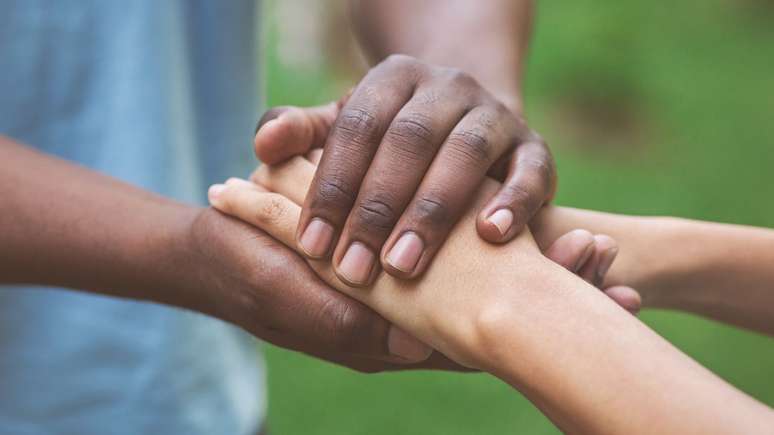Transform thoughts, emotions and habits and create new paths with awareness
Is it possible to rewire the brain?? A decade ago, neuroscientists would say no, our neurons don’t change throughout our lives. But now the opposite has been proven.that our brain has neuroplasticity, the ability to “reshape” ourselves throughout our lives through our experiences, thoughts, and emotions. One way to do this is to include mindfulness in your everyday life.
But how does this happen? How to reprogram my brain? In this article, I explain all of this and teach you simple practices and mini breaks from Mindfulness (full attention) for you pto calibrate the nervous system.
Mindfulness: Rewiring the Brain
You can imagine your brain as a dynamic energy network connected with billions of pathways or highways that light up every moment you think, feel, or do something.
Some of these roads are often explored a lot, they correspond to their habits, ways of thinking, feeling and doing. So, every time we think a certain way, practice a task, or feel a specific emotion, we strengthen this path.
Por that, it becomes increasingly easier for electrical impulses from neural networks to travel this path. That is, our focus of attention, beliefs, and habits determine which neural networks will be strengthened or weakened.
Basically, it means that when we get into cycles of worry and anxiety or irritability, these will be the neural networks that get reinforced.
Similarly, when we have rigid habits or limiting beliefs, we become uncreative and “stuck” to the same brain pathways, which makes it impossible to activate an arsenal of new pathways, or rather, the mind’s full intelligent potential.
So the more we worry, the better we learn in the art of worrying. When we complain, we get better at that art too. The more we cultivate positive emotions, the more emotionally adept we become in this regard.
reptilian brain
Furthermore, our brain still resides in the old reptilian brain, where the amygdala is located. It’s responsible for our “fight and flight” response, which kicks in when we feel threatening or stressful situations, and releases hormones and chemicals like cortisol and adrenaline.
This is why stress has such a huge impact on us and why we are often in such cycles that we burn out. In this case, the “blindness” caused by the agitation of the mind under stress also makes it impossible for the mind to find these new avenues.
Here’s how to use mindfulness to manage stress.
Awareness helps change habits
Being in a state of Mindfulness in life is a constant exercise of our attention and requires a lot of disciplined practice. But the practice accompanied by other habit changes helps us in this process of transformation and deconditioning of the mind.
How about starting now? Try it:
- Look closely at where you sit at home, work, restaurant.
- Change the chair, armchair or place you usually choose.
- Brush your teeth with the opposite hand than usual.
- Pick a task where you observe some stiffness in resisting changing this habit.
Try to see how these simple changes can give another perspective to a small moment in your life.
- What has changed?
- How do you feel different?
- Did you feel any discomfort?
The process of change passes through this listening and awareness. Here are more tips for putting mindfulness into your routine.
Mindfulness in everyday life
The following techniques help to create mini breaks during the day to calibrate the nervous system. They are short but very effective when done in combination with a disciplined daily mindfulness practice.
Two feet, one breath
It is the shortest mindfulness technique. Repeat frequently throughout the day to remind yourself that you are actually living in a physical body.
- Feel one of your feet, then the other.
- Take a conscious breath.
the three ps
- Break: take a moment for yourself. Even if it’s a simple breath. Let go of the task-oriented mind and just observe the moment.
- Presence: Be present and aware of what is happening right now. Experience the sensations of the body, observe the thoughts and feel the emotions as they are, without trying to change anything.
- proceed: Using words mindfully, respond with compassion to whatever needs your attention right now.
If you need help, you can count on me. Call me here.
Mindfulness and neuroplasticity
Practicing mindfulness helps develop attention skills and the ability to direct awareness to the present moment with openness and kindness.
This means that we are less inclined to make decisions based on unconscious contents, on reactive impulses, and it makes room for mental clarity and a mind always eager to explore new paths.
According to Tarchin Hearn, master of meditation and mindfulness and author of the book “Satipatthana: Fundamentals of Mindfulness”, cultivating this practice means growing consciously, maturing towards a fluid and functional integration of an embodied and interactive experience.
ORthat is, not living by identifying and believing only in one’s mental contents, but being more aware of one’s body, one’s inner wisdom and one’s relationships with others and with nature. It is the opposite direction that leads us to frustration, pain, turmoil, fragmentation and distrust.
I would also add that it is entering a process of deconstruction, which leads us to meet our true nature and develops a lively mind, always ready to explore the curious universe of infinite possibilities. Which direction do you want to go?
The mail Mindfulness in Everyday Life: Find out how to rewire your brain appeared first on Personalize.
Fernanda Miguez (contato@fernandamiguez.com.br)
– She is an astrologer trained by the Astrology Society of Rio de Janeiro (SARJ) and creator of the Astrology of Consciousness Project. She worked for 10 years in the team of astrologer Maria Eugênia de Castro and as a contributor to 13 books in the area. She is an engineer from the UERJ, currently a student of Psychology. She is trained in the area of self-knowledge, she works as a Mindfulness trainer at MTi (Mindfulness Trainings International) and is a professor of Cultivation of Emotional Balance at Albert Einstein-SP.
Source: Terra
Ben Stock is a lifestyle journalist and author at Gossipify. He writes about topics such as health, wellness, travel, food and home decor. He provides practical advice and inspiration to improve well-being, keeps readers up to date with latest lifestyle news and trends, known for his engaging writing style, in-depth analysis and unique perspectives.








